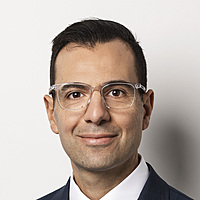How to unearth value in the mining sector
Fortunes have been made and squandered in Australian mining cycles, time and time again.
From the meteoric rise and fall of Poseidon Nickel in 1970 to the coal boom in 2008 that turned an electrician from Muswellbrook NSW into a billionaire before losing it all, the mining sector is known for its volatility and dramatic shifts in fortune.
The cyclical nature of mining is such that soaring commodity prices become the industry's Achilles' heel, as high prices spur increased supply.
When new supply enters the market and demand is unchanged, commodity prices can fall precipitously. Conversely, commodity prices rise again when unprofitable mines are shuttered, and demand eventually surpasses supply.
This phenomenon mirrors Joseph Schumpeter's "Creative Destruction" concept, where periods of high returns attract new investments, only to see capital exit the industry when returns are low.
This constant ebb and flow of capital dictate commodity bull or bear markets, driving outsized moves in company share prices.
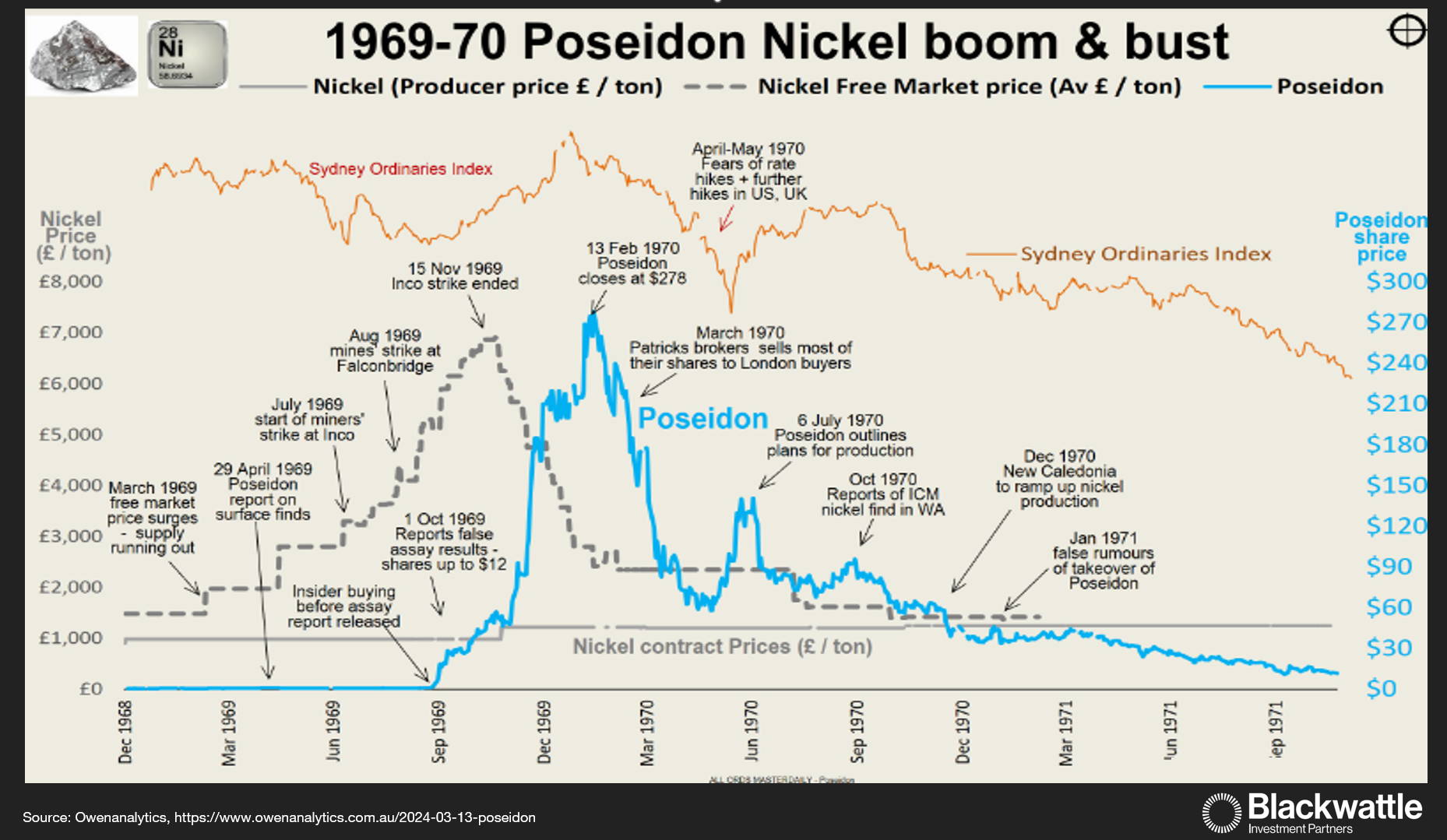
The mining cycle rules of investing
So how do you keep your head while others are losing theirs?
A contrarian approach is often necessary since investors typically chase rising commodity prices and panic when prices bottom out.
Above all, owning quality mining companies with the following attributes can serve investors well:
- Low-cost producers: Look for mines in the first or second quartile of the cost curve.
- Long reserve lives: Seek out long-life mines and avoid depleting assets.
- Low-risk sovereign jurisdictions: Invest in regions where the rule of law protects asset owners.
- Strong balance sheets: Avoid indebted companies that could become distressed in bear markets.
- Management: Seek aligned teams with a history of counter-cyclical capital allocation.
- Commodity prices: Focus on companies near cost curve levels that don't support significant supply growth.
In the end, commodity prices drive the share prices of mining companies, but the low-cost tier-one producers are the ones that deliver cash returns to shareholders.
Why is this framework critical?
Companies that meet this criterion have greater odds of surviving the notorious commodity cycle.
Being low on the cost curve means the mining asset is profitable at almost all times of the price cycle.
Explorers and developers, on the other hand, are highly dependent on external funding, which can quickly dry up in commodity bear markets.
When this happens, investors are left with a patch of dirt that not even a Sydney-based property developer would touch.
While the untapped resources of developing countries can tempt you, the importance of low-risk sovereign jurisdictions is evident by the following examples where shareholders were punished from changing licencing rights:
- In 2022, the Serbian Government canceled Rio Tinto's license for the Jadar project.
- In 2023, Leo Lithium (ASX: LLL) and AVZ Minerals (ASX: AVZ) shareholders suffered from Government requisitions of mining licences or forced divestments.
- In 2024, the Chilian Government, via Codelco acquired 50% of Sociedad Química y Minera (SQM) lithium brine assets in the Salar de Atacama region as part of its permit renewal.
Lastly, commodity prices, being near the marginal tonne of production, often cited as the 90th percentile of supply, are unlikely to attract significant new supply.
Perversely, the risk is the lowest when commodity prices are falling or toward the lower end of the cost curve for mining companies with tier-one assets.
To assess commodity price risk, the other sanity check is the implied payback period or return on funds employed for new mines at current commodity prices.
If returns are attractive, then supply will continue to build. If returns are poor, capital will exit the industry.
So, with this, we provide three companies that meet most of the criterion described above.
IGO Limited (ASX: IGO)
Lithium prices are tanking, brokers are cutting estimates, and share prices of lithium producers are plummeting.
At current spodumene lithium prices, few hard rock miners are generating much free cash flow today.
IGO stands out as one of the few due to its 25% ownership of the Greenbushes mine in Western Australia, which forms the most significant component of IGO's valuation today.
Greenbushes is the largest producer of hard rock spodumene in the first quartile of the hard rock cost curve, with a c1 cost of USD $254/t.
Its low-cost position is underscored by an industry-leading reserve grade of 1.9%, compared to newer mines at 1.0 - 1.2% and marginal mines out of China, which operate at grades of 0.3%-0.5%.
Greenbushes' mine life extends just beyond 2040. However, management recently confirmed a "very significant" opportunity to expand mine life given the limited exploration investment to date. This is evident when drilling results in 2023 expanded reserves by 25%.
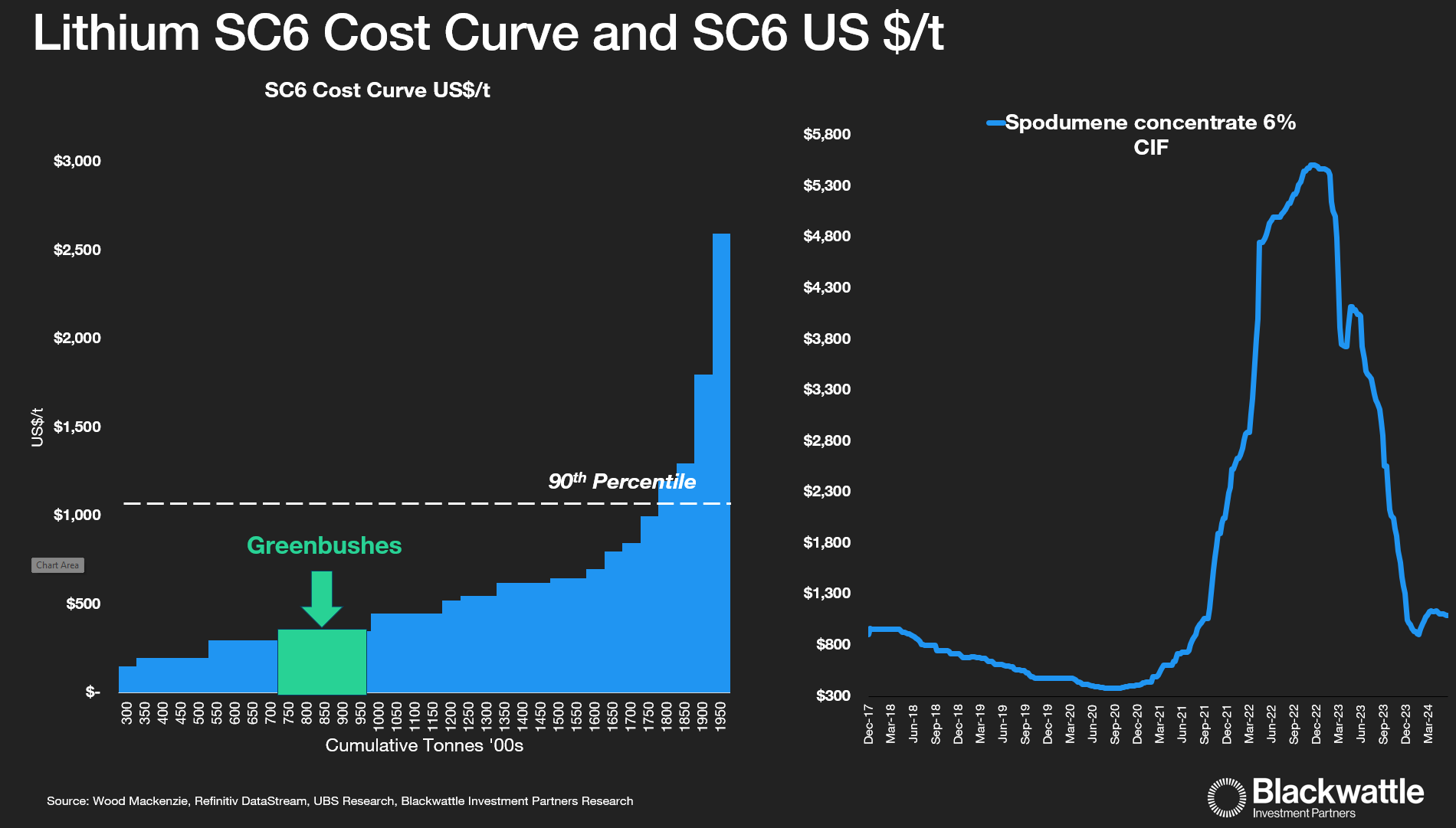
While brine is lower cost, we prefer hard rock spodumene mines such as Greenbushes because brine operations are in higher-risk jurisdictions. Brine operations are also difficult to scale due to an intricate chemical process that makes them dependent on water supply, causing operating challenges in dry conditions.
At present, the market is awash with supply from marginal-cost lepidolite mines in China and new hard rock mines in Africa. Slowing electric vehicle sales has compounded this, leading to higher inventory levels along the battery supply chain.
To gauge where the long-term price for spodumene could settle, it's worth looking at Pilbara Minerals' (PLS) recent plans to expand to 2 million tonnes per annum.
To justify the A$1.2bn plant expansion (not including mine development), PLS assumes a real SC6 price of US$1500/t, well above current levels.
Let's take the current SC6 price of US$1000/t. PLS will only generate a return on capital (all in cost, including royalties, mine development, and sustaining capex in nominal dollars) of approximately 10%-11% or a payback just beyond mine life at 2mt.
Comparing this return to PLS' cost of capital of 8%, the expansion at SC6 US$1000/t generates little value for shareholders.
Eric Norris, Albemarle President of Energy Storage, recently echoed this view:
"The current price of the key battery ingredient is "concerning", and investors shouldn't put money into lithium facilities at these market levels".
Secondly, all in cost per tonne for Chinese lepidolite supply is approx. US $10,200 per LCE/t, which equates to approx. US$962/t SC6, close to the current price.
This suggests that market pricing is nearing a level where supply growth should start to respond once excess inventory clears.
We wouldn't be surprised if chemical processing companies start to consolidate low cost spodumene miners given excess conversion capacity in China is likely to shift industry returns to upstream miners.
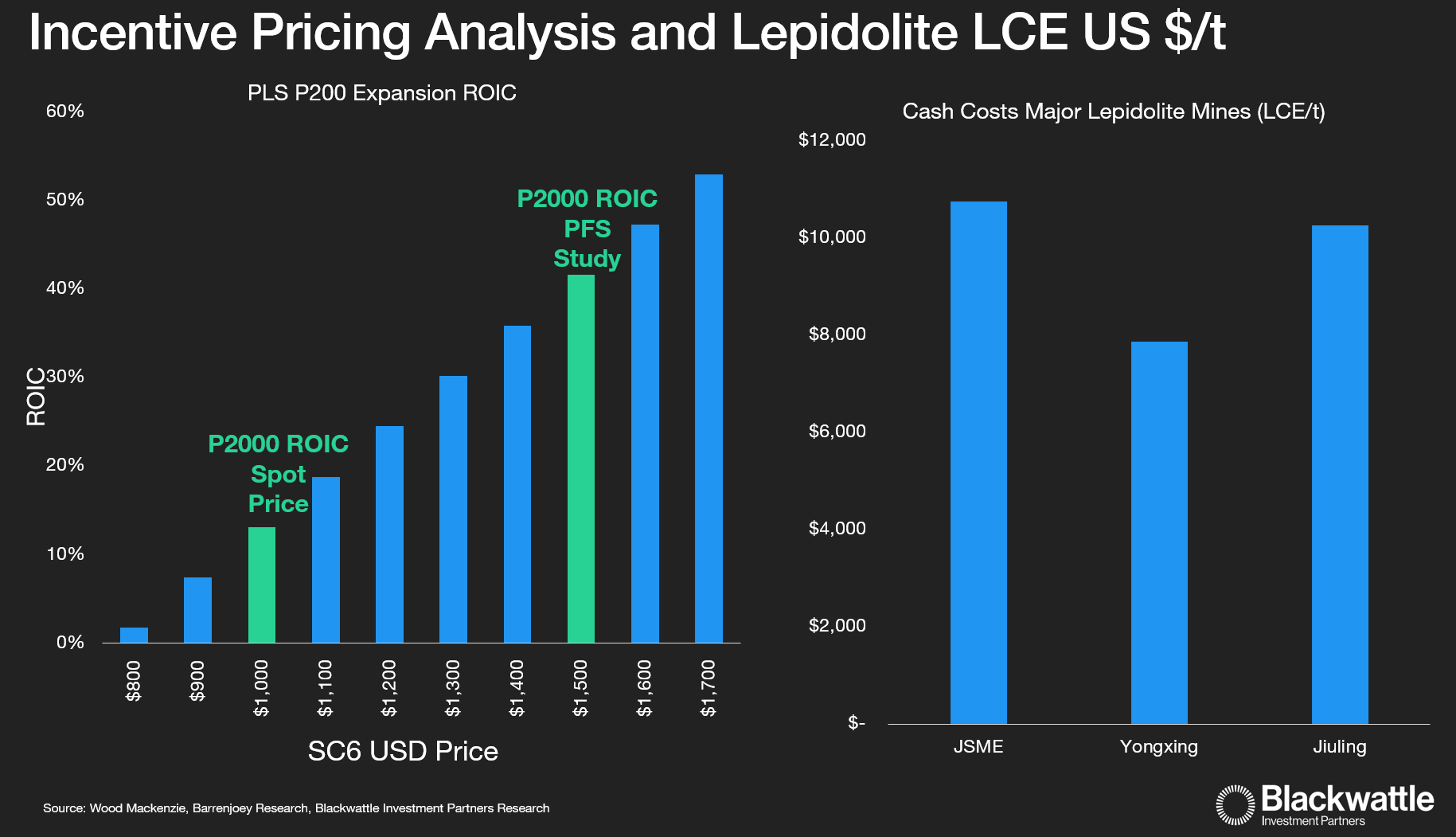
Newly appointed CEO Ivan Vella comes with an impressive pedigree. He served as CEO of Rio Tinto Aluminium and Iron Ore and as the COO of operations in Mongolia, where he oversaw the construction of Rio's major copper project, Oyu Tolgoi.
Even after considering IGO's share of the net debt position within the Windfield JV (Greenbushes parent company), IGO's balance sheet is currently in a net cash position, positioning it well for an eventual recovery in lithium markets.
Assuming a marginal cost per tonne of US$1000/t for spodumene prices, IGO's enterprise value implies 10.5x in FY27 EBIT, not including its other assets such as the Kwinana refinery and nickel assets. Should prices recover to US$1200/t, the EBIT multiple drops to 6.7x.
However, if prices go lower, IGO's balance sheet positions it well to participate in industry consolidation or ride out the cycle.
Rio Tinto Limited (ASX: RIO) and Rio Tinto PLC (LON: RIO)
Rio Tinto offers investors exposure to iron ore, low-cost green aluminium, and a fast-growing copper production profile.
Rio Tinto's Western Australian Pilbara Iron Ore operations are highly prized assets, with few mining assets in the commodity complex having similar terms of scale, cost position, and reserve life.
What makes these assets attractive is the sheer amount of infrastructure within these operations connecting the network of iron ore mines.
This includes 2,000 kilometres of rail infrastructure and four significant ports accommodating 360 million tonnes of capacity.
These assets are unlikely to be replicated today for a commercial return, given the wide-scale inflation being experienced by the sector. Convert these assets into a regulated asset base (Aurizon (ASX: AZJ) or infrastructure asset (Mineral Resources (ASX: MIN), and investors will bid these assets up to P/E multiples of 15x-17x, nearly double Rio Tinto's current P/E valuation.
Rio Tinto's iron ore C1 cost of US$20/t is well and truly in the first quartile of the cost curve. Despite workforce shortages and high inflation levels, Rio Tinto's cost position has been bolstered by investments in integrated mine automation including autonomous trucks, trains and drills.
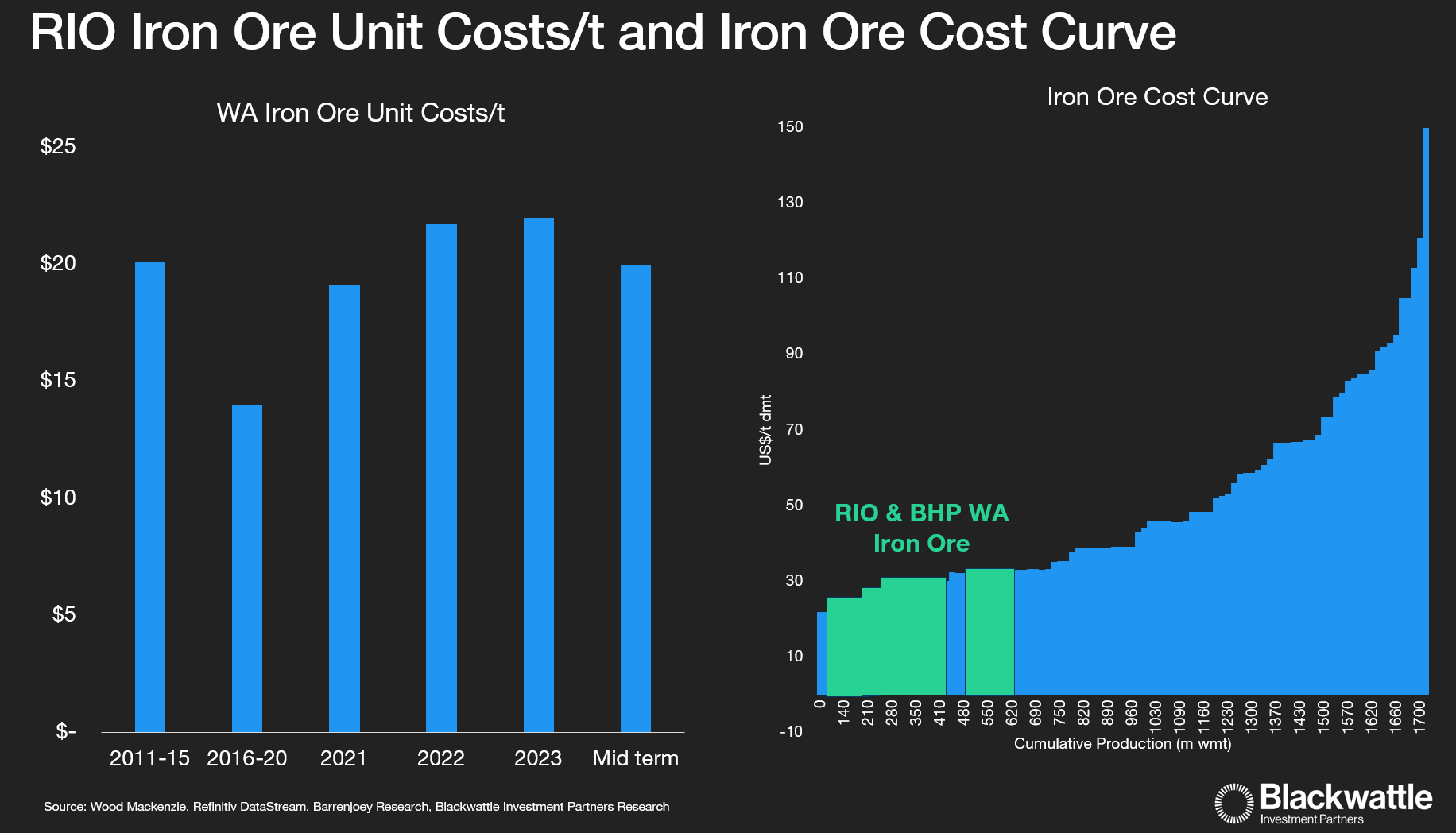
The outlook for iron ore is dependent on China, but India is also emerging with rapid steel production growth.
Despite a weak Chinese property market, demand for iron ore has been more resilient than expected due to infrastructure and social housing growth. Government steps to arrest the property market earlier this year suggest authorities' willingness to support the housing market. This may lead to future support packages to help stimulate demand.
Rising capital costs, growing mine depletions, particularly in the Pilbara region, and environmental challenges in Brazil have kept supply muted since 2017. While a new supply of 100mt is expected from Simandou from 2027-28, mine depletion and environmental challenges continue to persist across Australia and Brazil, which could counter some of this supply growth.
To quote BHP Dr Huw Mckay – Vice President, Market Analysis and Economics in 2023:
"We observed marginal seaborne supply coming under pressure when prices approached $100/t, with any dips below that threshold unable to persist for any meaningful length of time".
Should the iron ore price drop to the 90th percentile price, RIO's low-cost operations will still produce significant cash flow back to shareholders, while other high-cost producers are pushed out further on the cost curve when Simandou ramps up.
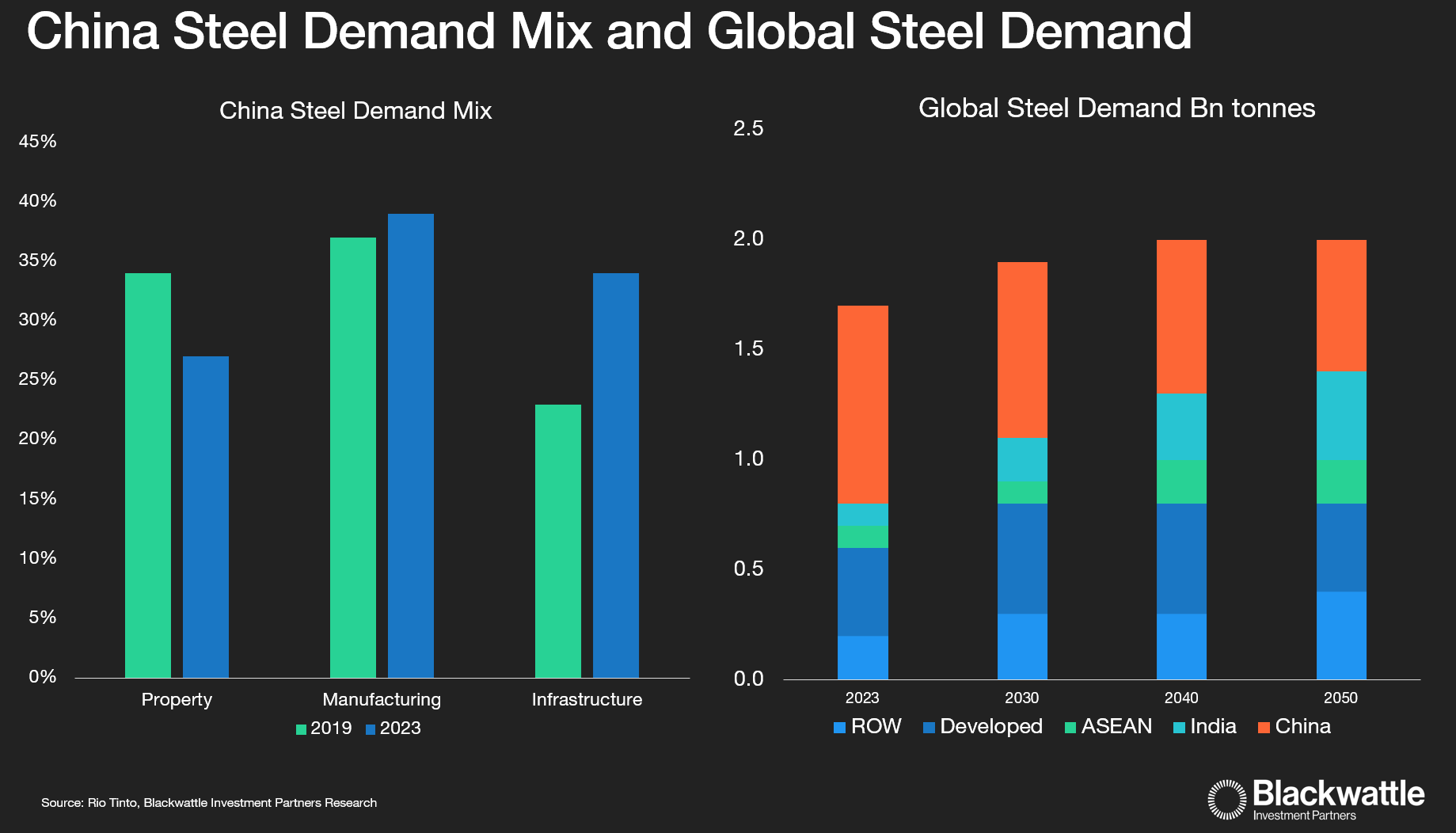
What is more exciting for RIO shareholders is the growing green metal commodity mix.
RIO's flagship copper mine, Oyu Tolgoi, will progressively ramp up to 550kt of copper production by 2030. The ore body is an above-grade deposit at 0.88% CU and a high-scale operation using block cave mining methods.
While block cave mining requires high upfront development costs, it's a cost-effective underground mining method with lower sustaining capital requirements than traditional stope mining. Oyu Tolgoi will be a tier 1 asset positioned in the first quartile of the cost curve with an AISC of near US $1.00/lb.
The copper price is well positioned in the medium term due to sparse supply growth and a strong demand outlook. Demand is expected to accelerate from energy storage, electricity grid modification, and electric vehicle applications, with these applications expected to grow from 7% in 2023 to 22% of combined copper/aluminium demand.
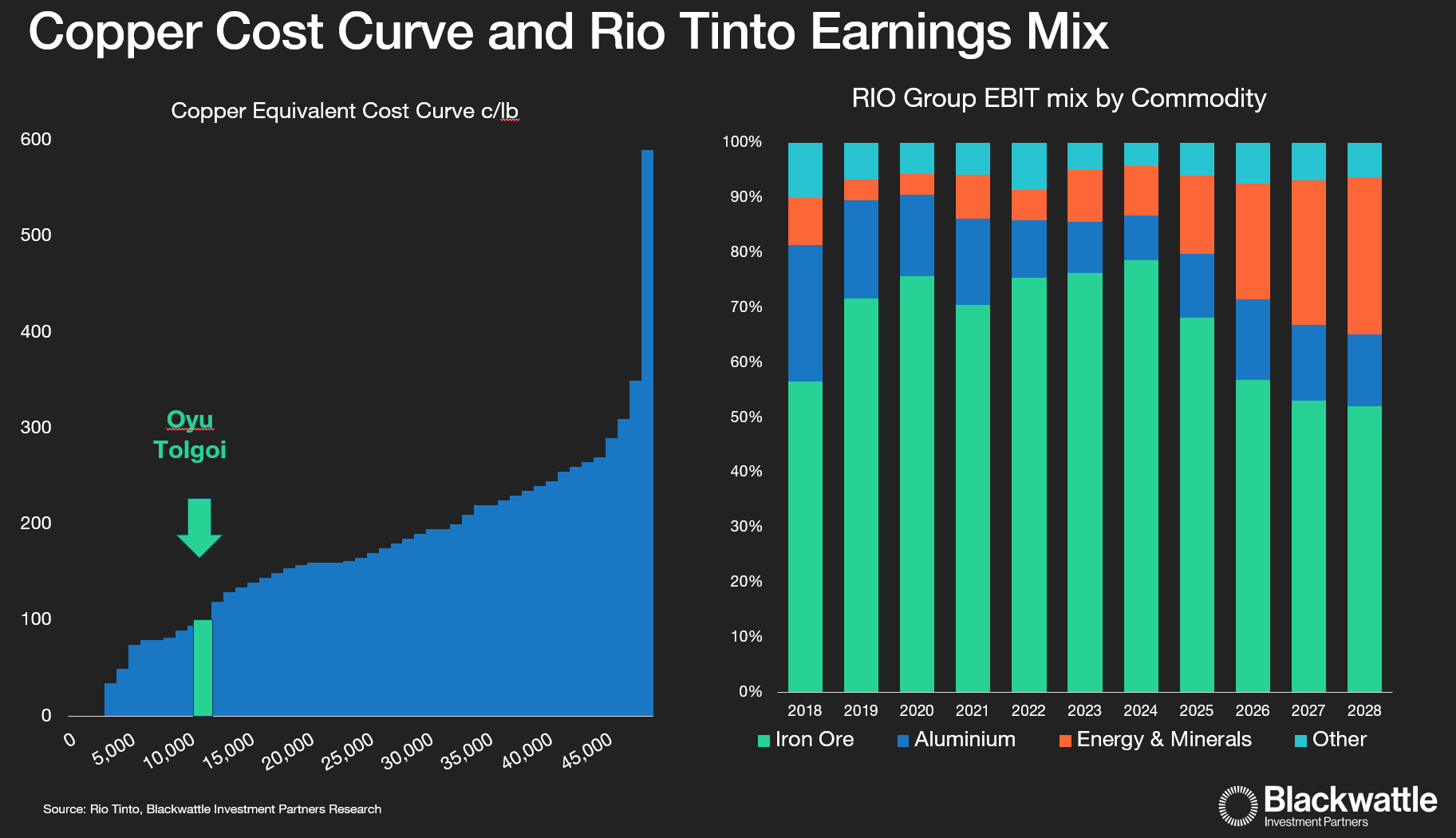
Using a long-run copper price of US $4.50/lb and an iron ore price of US$80/t, RIO's earnings mix from copper and aluminium will grow to US $7bn by 2028, accounting for 40% of group EBIT.
Adjusting these assumptions to US$5.00/lb and $US75/t, RIO will generate US$8bn of EBIT from copper and aluminium, representing 50% of group EBIT.
Based on the former assumptions, Rio Tinto Limited (RIO.AX) is trading on an FY27 EBIT multiple and dividend yield of 6.9x and 5.8%, while Rio Tinto PLC (LON: RIO) is trading on an EBIT multiple and dividend yield of 5.5x and 7%. Current trading multiples are even lower given an iron ore price of US$100/t.
Modest net debt levels of 0.1x debt to EBIT could also pave the way for capital management initiatives.
New Hope Group (ASX: NHC)
On the other side of the stalling electrification trend are fossil fuels, which will be around much longer given the burgeoning capital costs of decarbonisation and the growing penetration of plug-in hybrid vehicles.
New Hope Group operates the Bengalla and New Aceland mines in NSW and QLD, which produce high-quality thermal coal for electricity generation.
Bengalla is the jewel in the crown with a reserve life that supports a mine beyond 2039 and a C1 cost per tonne of A$79/t, positioning it in the first quartile of the cost curve.
Australian coal, such as that produced by Bengalla, is of the highest quality globally due to its low impurity and high energy content, which is 1.5x the calorific value per tonne compared to Indonesian coal, the largest source of coal exports in the world.
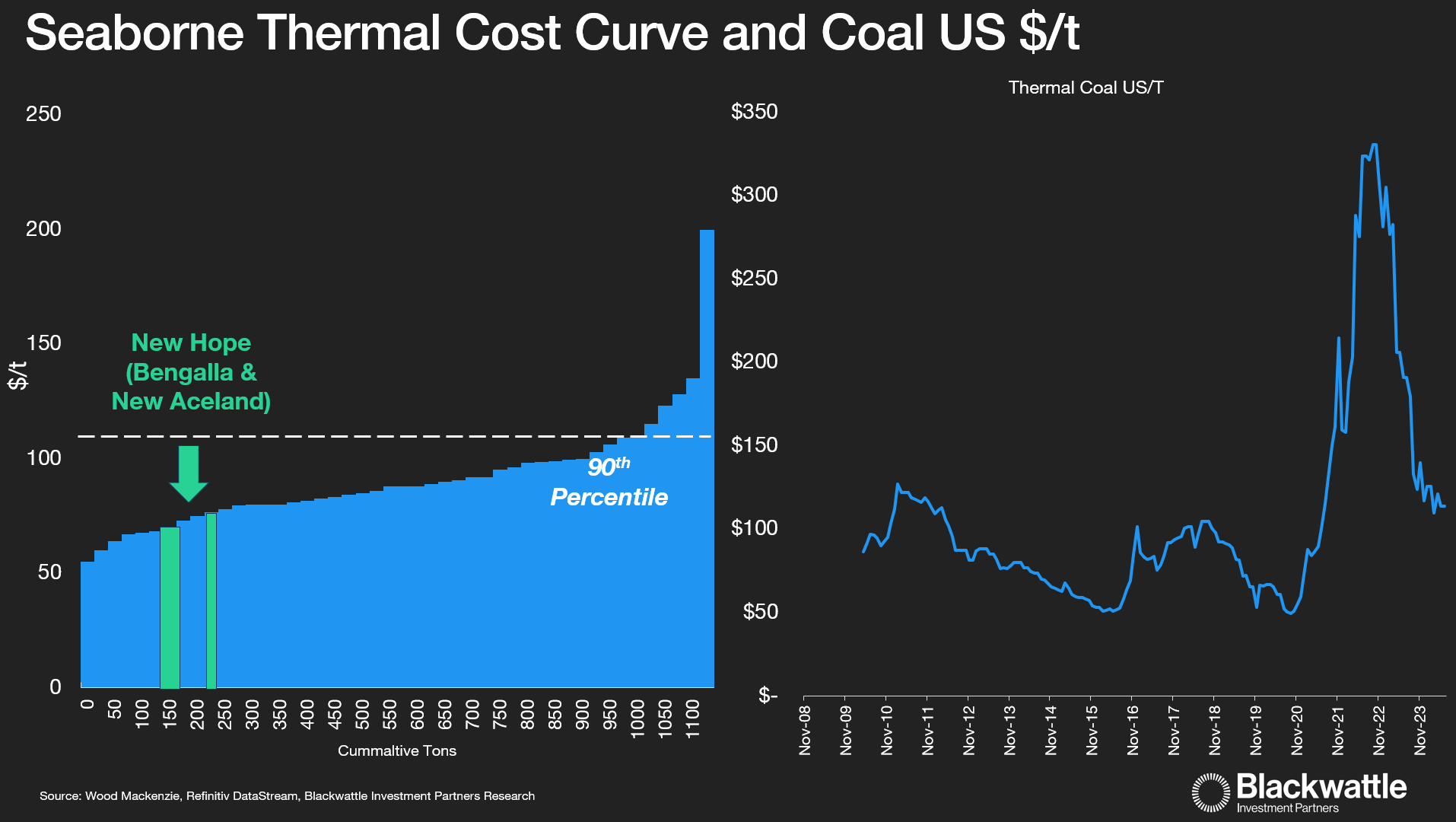
While demand for thermal coal has been forecast to decline from the transition to renewable energy generation, demand has continuously surprised to the upside.
There is a growing consensus that energy security concerns and the eye watering cost to bring on new energy generation capacity will see coal remain in the generation mix for some time.
Governments have realised the transition will take longer and be far costlier and are paying operators such as Origin Energy (ASX: ORG) and AGL Limited (ASX: AGL) to keep operating coal plants.
For example, the Snowy Hydro 2.0 project is forecast to cost A$13bn compared with initial expectations of A$2bn in 2017. It may not be online until 2029, eight years later than original expectations.
The Coalition's proposed nuclear infrastructure investment is expected to cost over A$116bn and will not be ready until 2035 (at best). While nuclear is a logical solution, it's not a fait accompli as it does not have bipartisan support.
With cost-of-living pressure being a contentious political issue, coal-fired plant retirements are unlikely in the near term. Simply put, the world needs more reliable base-load energy generation.
In 2023, demand for seaborne coal was up 11% year over year, driven by China importing 53% more tonnes and Europe suffering from gas shortages, which led to a restart of coal-fired electricity generation.
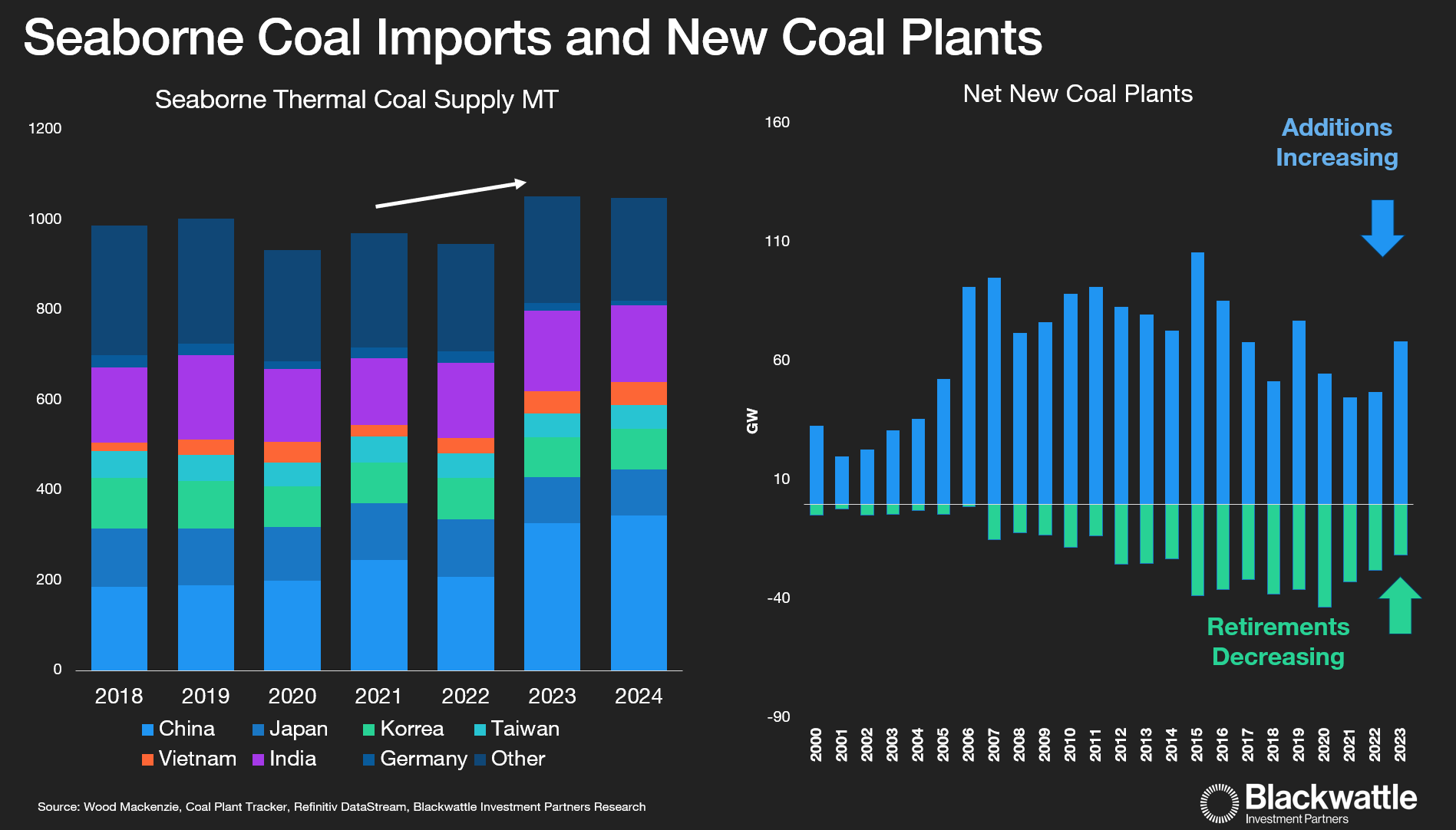
The Western world's supply of thermal coal is also constrained by a lack of funding and permitting challenges. New Hope's New Aceland is an example. The mine faced years of opposition and high court challenges before finally being awarded a permit to restart the Stage 3 mine in 2022 after first submitting the application in 2007.
Countries are also starting to prohibit exports. Canada will end coal exports by 2030. South Africa recently implemented export bans to shore up domestic energy requirements. Colombia has also proposed banning new coal mines.
Meanwhile, the explosion of data centers is only perpetuating energy grid shortages in parts of the USA, the vanguard of AI investment.
Today, AI data centres are the modern-day equivalent of an aluminium smelter in terms of energy demand.
This is due to Chat GPT inference queries requiring 10x the power intensity than traditional data centre cloud applications.
A case study is Virginia, USA, where power demand has increased 40% since 2016 compared with the rest of the USA. Based on a few scenarios, market forecasters suggest that Europe, the swing importer of thermal coal, could also see a similar increase in power demand.
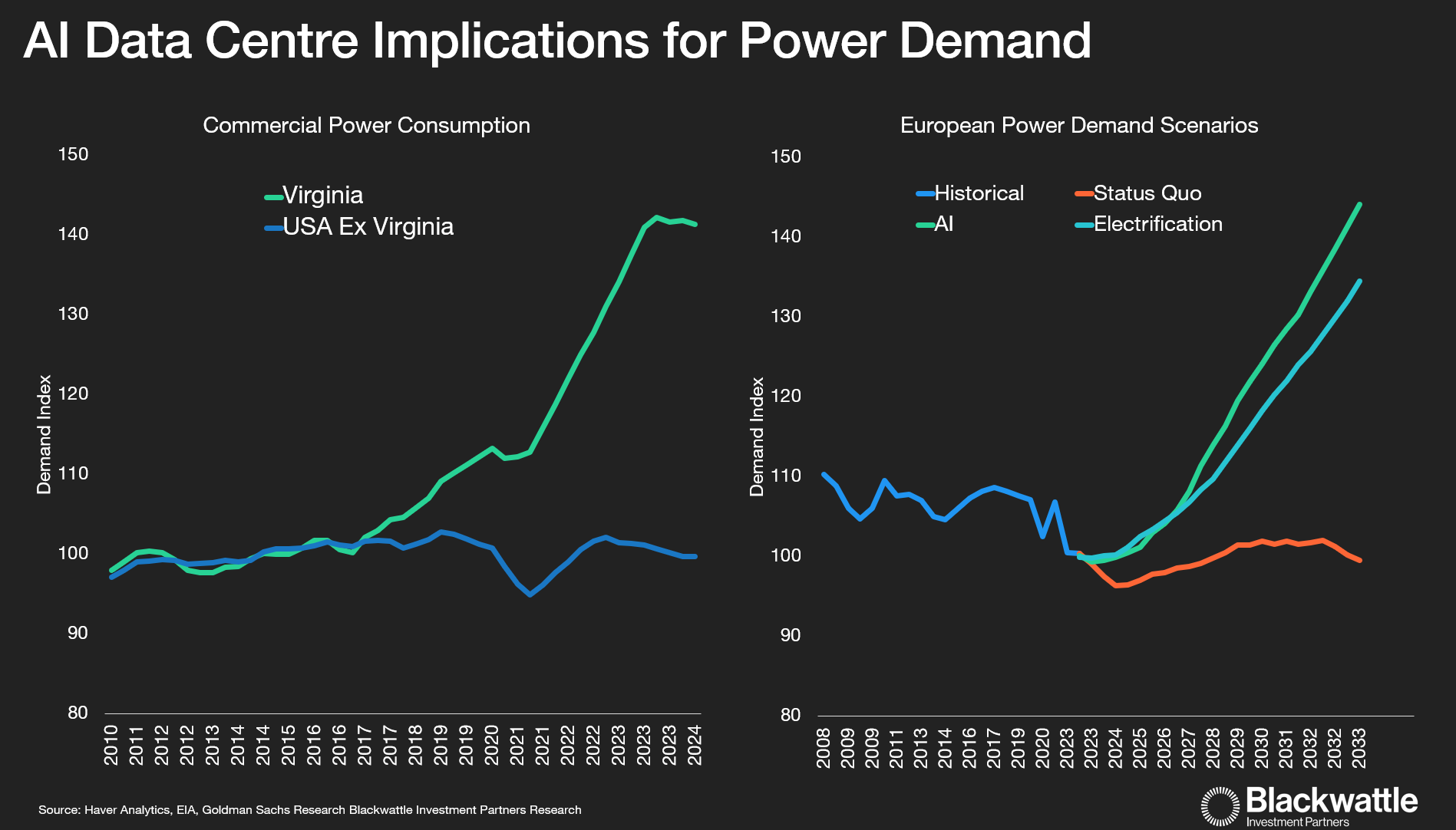
The Millner Family, which controls New Hope through the Washington H Soul Pattinson Company, has also shown a contrarian approach to capital allocation. The 80% interest in Bengalla was purchased from Rio Tinto and Wesfarmers (ASX: WES) for A$1.6 billion when thermal coal prices were less than US$46/t.
NHC's balance sheet is solid, with net cash and investments of A$0.4bn, positioning well to acquire further stranded coal assets, most likely metallurgical coal.
Using a long price of US$100/t (vs. the current US$130/t), NHC is trading on 7.2x FY27 EBIT, which we think is too pessimistic, given that coal demand is likely to stay elevated for some time.
Adjusting the thermal coal price assumption to US$130/t, and the EBIT multiple drops 5.7x.
History Repeats, First as a Tragedy, Second as a Farce
If there are lessons to take from the boom and bust of nickel in the 1970s, coal in 2008, and the recent lithium mania, its human emotions are a threat to reason. When there are extreme swings in commodity prices, irrationality can easily trump sober calculation.
Investors should take solace in knowing that supply and demand will eventually find an equilibrium where only top-tier, low-cost assets can thrive, eventually emerging stronger for the next upswing in commodity prices.
This belief underscores our philosophy of investing in quality tier-one miners capable of enduring periods of weak commodity prices.
5 topics
12 stocks mentioned
